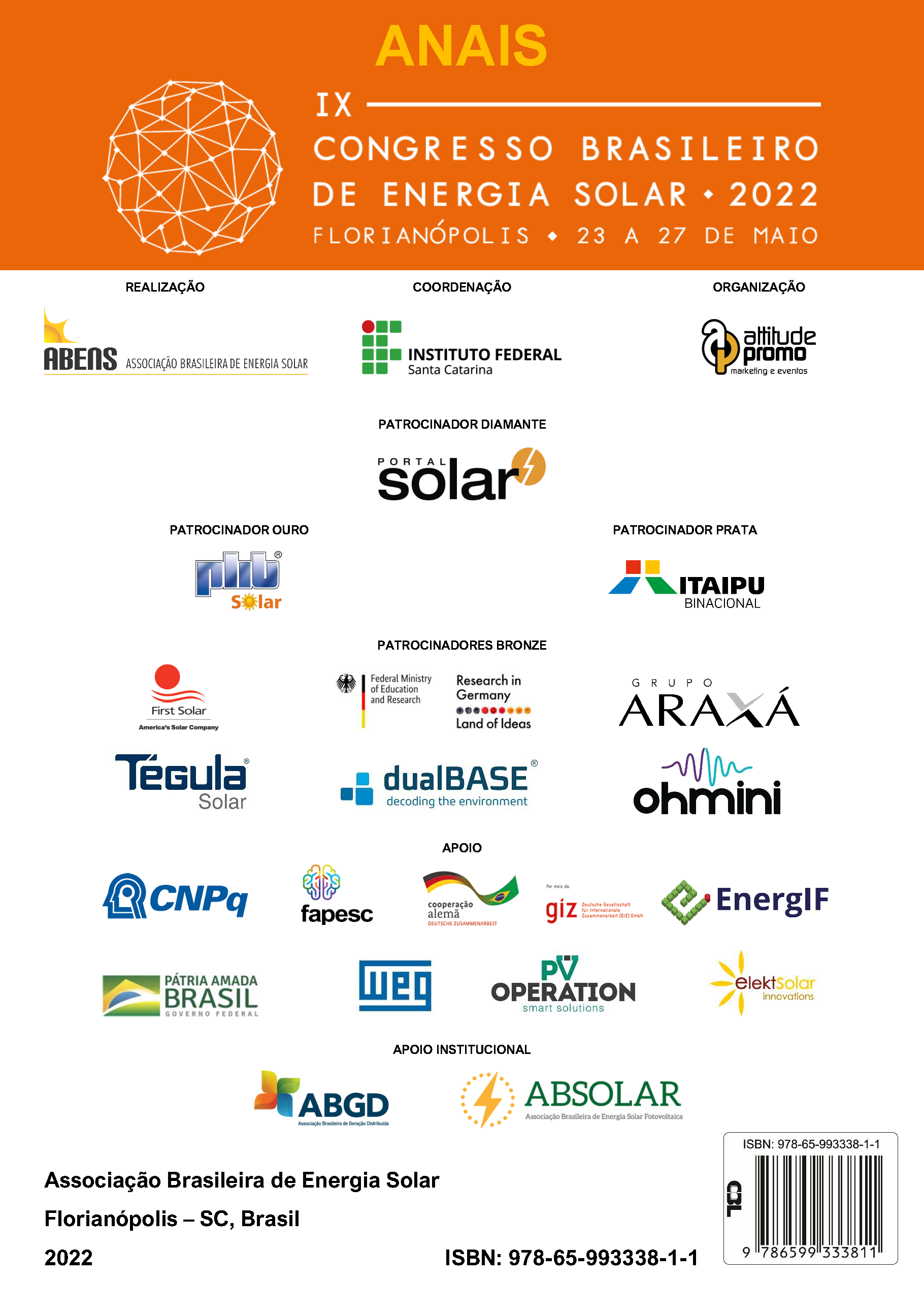VALIDATION OF 441 TYPICAL METEOROLOGICAL YEAR (TMY) CREATED WITH INMET/BRAZIL STATIONS DATA
DOI:
https://doi.org/10.59627/cbens.2022.1173Palavras-chave:
Typical Meteorological Year, INMET/Brazil, Atlas Brasileiro de Energia SolarResumo
Renewable energy sources are essential to solve the problem of scarcity of fossil fuels that we will face in the future, without compromising our quality of life. Yet, the deployment of these technology, especially solar energy, requires a detailed yield, economic and risk analysis to secure financing options. To do so, a set of specialized software (or tools) are used, requiring meteorological and irradiation data as input, known as typical meteorological year (TMY). Recently, our group generated 441 TMY files from the data of the largest weather station network in Brazil, operated by the National Institute of Meteorology (INMET). The authors used the BRL-Brazil separation model to estimate the diffuse and direct normal irradiance and applied the Sandia Method to generate the TMY files. Although the authors generated and provided TMY files across Brazilian territory, it lacks a thoroughly analysis of the accuracy of the generated TMY files and the original data of the INMET station. Cross-validation between the irradiance values in the TMY files and the irradiance data provided in the Brazilian Solar Atlas. The TMY were validated comparing the yearly and monthly means of daily GHI totals from the files against the values provide by the Brazilian Solar Atlas. Small differences were found, with TMY yearly means of GHI differing an average 2% in relation to the Atlas, with maximum deviations are not larger than 10%. Regarding the DNI and DIF values from the TMY, the deviations between the TMY and the Solar Atlas were significantly larger than the deviations found for GHI. This can be explained by the inherent uncertainty in DNI and DIF methods of estimations used to generate the TMY files (BRL-Brazil) and in the Solar Atlas (Brasil-SR). After this validation study, it can be said that Brazil has a database with TMY for 441 cities with known uncertainties, all of which can be used to support solar studies on a continental scale.
Downloads
Referências
Cebecauer, T., Suri, M., 2015. Typical Meteorological Year data : SolarGIS approach 69, 1958–1969.
Dorneles, R., Bravo, G., Starke, A., Lemos, L., Colle, S., 2019. Generation of 441 Typical Meteorological Year from Inmet Stations - Brazil. In: Proceedings of the ISES Solar World Congress 2019. International Solar Energy Society, Freiburg, Germany, p. 1–12.
Driemel, A., Augustine, J., Behrens, K., Colle, S., Cox, C., Cuevas-agulló, E., Denn, F.M., Duprat, T., Fukuda, M., Grobe, H., 2018. Baseline Surface Radiation Network ( BSRN ): structure and data description ( 1992 – 2017 ). Earth Sysytem Sci. Data 10, 1491–1501.
ECMWF, 2017. Copernicus Climate Change Service: ERA5: Fifth generation of ECMWF atmospheric reanalyses of the global climate. [WWW Document].
Fiebrich, C.A., Morgan, Y.R., Mccombs, A.G., Hall, P.K., Mcpherson, R.A., 2010. Quality assurance procedures for mesoscale meteorological data. J. Atmos. Ocean. Technol. 27, 1565–1582.
Hall, I.J., Prairie, R.R., Anderson, H.E., Boes, E.C., 1978. Generation of a Typical Meteorological Year for 26 SOLMET stations, SAND-78-1096C; Albuquerque, New Mexico, USA.
Hirsch, T., 2017. SolarPACES guideline for bankable STE yield assessment. IEA-SolarPACES 190.
Lemos, L.F.L., Starke, A.R., Boland, J., Cardemil, J.M., Machado, R.D., Colle, S., 2017. Assessment of solar radiation components in Brazil using the BRL model. Renew. Energy 108.
Liston, G.E., Elder, K., 2006. A Meteorological Distribution System for High-Resolution Terrestrial Modeling (MicroMet). J. Hydrometeorol. 7, 217–234.
Long, C.N., Dutton, E.G., 2010. BSRN Global Network recommended QC tests, V2.0. Bremerhaven, PANGAEA.
Moura, A.D., Tadeu, L., Fortes, G., 2016. The Brazilian National Institute of Meteorology ( INMET ) and its contributions to agrometeorology. Agrometeoros 24, 15–27.
Pereira, E.B., Martins, F.R., Abreu, S.L., Rüther, R., 2017. Brazilian Atlas for Solar Energy.
Wilcox, S., Marion, W., 2008. Users Manual for TMY3 Data Sets, National Renewable Energy Laboratory.


